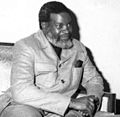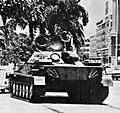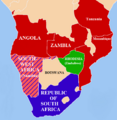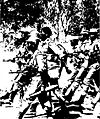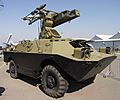South African Border War facts for kids
Quick facts for kids South African Border War |
|||||||
|---|---|---|---|---|---|---|---|
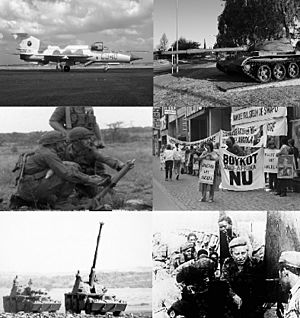 Clockwise from top left: FAPLA MiG-21bis on an airstrip; FAPLA or Cuban T-62 tank captured by the SADF; 1981 protests against SADF aggression in Angola; Soviet advisor with FAPLA subordinates; G6 howitzers just prior to their deployment to Cuito Cuanavale; South African expeditionary troops in the operational area |
|||||||
|
|||||||
| Belligerents | |||||||
| 1966–1974: |
1966–1974: |
||||||
| 1975–1990: |
1975–1990: |
||||||
| Casualties and losses | |||||||
The South African Border War was a long conflict that happened mostly in a place called South-West Africa (which is now Namibia). It lasted from 1966 to 1990. This war was mainly between South Africa and a group called the South-West Africa People's Organisation (SWAPO), along with their friends and allies.
Contents
How the Conflict Started
The story of this war goes back to World War I. During that war, South Africa invaded and took control of a German colony called German South-West Africa. This was done to help the British Empire and its allies.
After World War I
After Germany lost World War I, a group called the League of Nations gave South Africa a special job. South Africa was told to manage the territory until the people living there were ready to rule themselves. This was called a "mandate."
After World War II
After World War II, the United Nations (a new international group) wanted South Africa to give up its control of South-West Africa. They suggested a "Trusteeship agreement." However, South Africa refused. Instead, South Africa wanted to make South-West Africa its fifth province. They even allowed white people in South-West Africa to vote for representatives in the South African Parliament.
SWAPO and the Fight for Independence
In 1962, a group called SWAPO was formed. Their goal was to fight against South African rule and gain independence for South-West Africa. SWAPO got help from the Soviet Union. They began training fighters, also known as guerrillas. From 1966 onwards, these fighters often clashed with the South African police and army.
The War Expands
The war changed a lot in 1975. This was when Angola became an independent country. Angola's new government, which was communist, started to support the SWAPO fighters.
Battles in Angola
Because Angola was helping SWAPO, South African troops began to launch attacks into Angola. Their goal was to destroy SWAPO bases. These attacks led to battles with the Angolan army. Cuba had sent its own troops to help the Angolan government, and they also got involved in some of these battles.
Peace and Independence
In 1988, South Africa, Angola, and Cuba signed an important agreement called the Tripartite Accord. This agreement was a promise to work towards peace.
The Agreement's Outcome
As part of the agreement, Cuba agreed to take its troops out of Angola. In return, South Africa agreed to leave South-West Africa and grant it independence. South-West Africa finally became an independent country called Namibia in early 1990.
Images for kids
-
Sam Nujoma, founder and leader of SWAPO.
-
Equipment of Soviet origin supplied to SWAPO. From left to right: satchel, Dragunov sniper rifle, PG-7V RPG projectile, and RPG-7 launcher.
-
South African armoured column in Ohangwena, 1970s.
See also
 In Spanish: Guerra de la frontera de Sudáfrica para niños
In Spanish: Guerra de la frontera de Sudáfrica para niños


